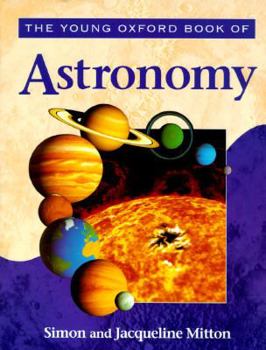Astronomy
Select Format
Select Condition 
Book Overview
"Look up on a clear, dark night and you will see the sky is full of twinkling specks of light. What are these stars and planets? How far away are they? Can we learn more about them?"
Simon and Jacqueline Mitton begin The Young Oxford Book of Astronomy by tapping into that sense of mystery and wonder that the endless night sky stirs in each of us. They set out the aims and methods of astronomy, such as how astronomers map and measure the universe. Then they turn to our own solar system, detailing vital statistics in "Fact Files" for each planet, and highlighting important discoveries or remarkable characteristics. Finally, they move to the stars and the great wheeling galaxies of the vast universe. They tell us the life cycle of a star, describe a nova explosion in electrifying detail, and offer a time line that describes what was happening on earth when the light we see today first set out from a galaxy far, far away.
This story of astronomy unfolds alongside hundreds of magnificent color illustrations--the latest photographs from the world's largest telescopes, the most exciting images from space probes, and many fascinating explanatory diagrams and artists' visualizations. The index and glossary are excellent research tools, and a section devoted to star charts will delight any budding astronomers.
The Young Oxford Book of Astronomy is a great book for a curious child, but adults will find it useful and fascinating as well. It's an essential guide to the greatest show on Earth--the starry, starry sky.
Simon and Jacqueline Mitton begin The Young Oxford Book of Astronomy by tapping into that sense of mystery and wonder that the endless night sky stirs in each of us. They set out the aims and methods of astronomy, such as how astronomers map and measure the universe. Then they turn to our own solar system, detailing vital statistics in "Fact Files" for each planet, and highlighting important discoveries or remarkable characteristics. Finally, they move to the stars and the great wheeling galaxies of the vast universe. They tell us the life cycle of a star, describe a nova explosion in electrifying detail, and offer a time line that describes what was happening on earth when the light we see today first set out from a galaxy far, far away.
This story of astronomy unfolds alongside hundreds of magnificent color illustrations--the latest photographs from the world's largest telescopes, the most exciting images from space probes, and many fascinating explanatory diagrams and artists' visualizations. The index and glossary are excellent research tools, and a section devoted to star charts will delight any budding astronomers.
The Young Oxford Book of Astronomy is a great book for a curious child, but adults will find it useful and fascinating as well. It's an essential guide to the greatest show on Earth--the starry, starry sky.
Format:Hardcover
Language:English
ISBN:0195211693
ISBN13:9780195211696
Release Date:December 1995
Publisher:Oxford University Press, USA
Length:160 Pages
Weight:2.05 lbs.
Dimensions:0.7" x 9.0" x 11.3"
Age Range:12 years and up
Grade Range:Grade 7 and higher
Customer Reviews
1 rating
Young Oxford Book of Astronomy
Published by Thriftbooks.com User , 24 years ago
This is a beautiful book full of great diagrams illustrating some difficult concepts in astronomy (for example, our place in the universe), wonderfully labeled drawings of planets, and the best of astronomical photographs. There are illustrations on every page. Little boxes of information offer more detail on some subjects ("milestones to the moon" or facts about each planets). The chapters are fairly short and easy to read. After some introductory chapters about exploring the universe and the tools that astronomers use, the book generally goes outward from the earth to the moon, the sun, the solar system, to distant stars (and their exotic varieties), then our galaxy (the Milky Way), other galaxies, quasars, and ideas about the beginning and end of the universe. The tiny star charts weren't very useful, but the glossary is nice. Although the book is aimed at a younger audience, many adults may enjoy the easy to read text and excellent illustrations.





